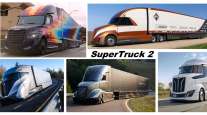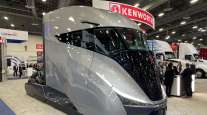Staff Reporter
Composite Use Cuts International SuperTruck II Mass by 60%

[Stay on top of transportation news: Get TTNews in your inbox.]
Navistar’s International SuperTruck II achieved a 60% reduction in weight compared with the baseline model due to a composite cab and trailer box, TPI Composites Senior Director of Automotive Todd Altman said Aug. 30.
The baseline model for the mass reduction comparison, which led to a doubling of fuel efficiency and 170% improvement in freight efficiency compared with SuperTruck I, was a 2009 International Prostar sleeper truck, Altman said.
Scottsdale, Ariz.-based TPI is best known for its composite wind turbines. Its composite material systems are a combination of fiber and resin.
Navistar is based in Lisle, Ill.
SuperTruck is a U.S. Department of Energy program launched in 2009 to help develop prototype trucks with improved efficiency and environmental standards. SuperTruck II launched in 2016.
TPI began working with Navistar on SuperTruck II in 2018. TPI had a relationship with Navistar for a number of years before working on the project, and in that time worked on replacing a number of components, Altman said.
One of the most beneficial factors in using composites is the investment needed in manufacturing of the vehicles, said Altman. Stamping die production lines typically cost around $80 million to $100 million, whereas a composite production line can tool up for a fraction of that cost, he said.
This has made working with TPI attractive to newer entrants to the automotive industry as well as legacy original equipment manufacturers, including in the commercial vehicle segment, Altman said. “The question is how we can waterfall technologies into production and trucks on the road?” he said.
The mass savings are set to be a major advantage for new generations of battery-electric trucks and hydrogen-powered vehicles that typically are heavier than their internal combustion engine counterparts, he said. There are also advantages when it comes to corrosion and insulation, he added.
Want more news? Listen to today's daily briefing above or go here for more info
“It is a really interesting time and composites have an opportunity to offer OEMs a significantly lower cost and higher performing product,” Altman said, adding that TPI is working with a number of legacy and new entrant OEMs in the commercial vehicle space.
Altman said TPI is working with one OEM (which he could not name) that will make a 200-kilogram (441 pounds) saving on panels on a Class 8 truck cab through the use of continuous fiber. More details are expected to be released before the end of 2023.
Navistar’s SuperTruck II shed 500 pounds when compared with the Traton Group unit’s SuperTruck I. The truck reached a fuel efficiency of 16 miles per gallon and a 170% improvement in freight efficiency compared with the 2009 baseline, the company said June 20.




